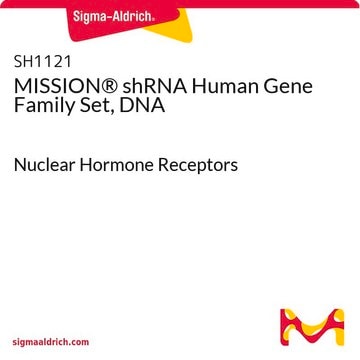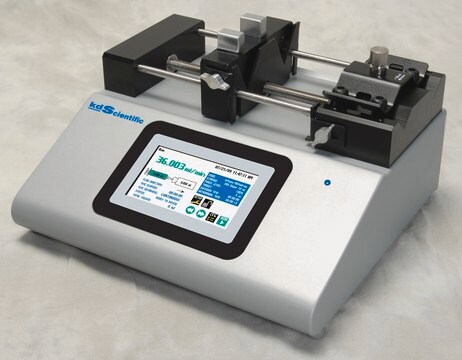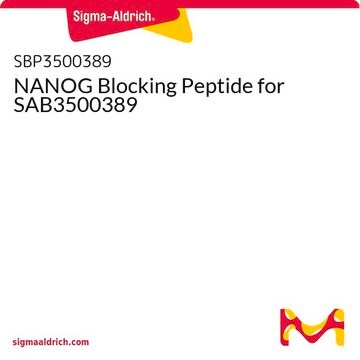SH0231
MISSION® shRNA Human Gene Family Set, Lentiviral Particles
G-Protein Coupled Receptors
Autenticatiper visualizzare i prezzi riservati alla tua organizzazione & contrattuali
About This Item
Codice UNSPSC:
41106609
NACRES:
NA.51
Prodotti consigliati
Nome Commerciale
MISSION®
Temperatura di conservazione
−70°C
Informazioni sul gene
Cerchi prodotti simili? Visita Guida al confronto tra prodotti
Descrizione generale
Lentiviral particles (representational, plate titer) are provided in 96-well plates that are barcoded for simple identification. Aliquots of 4 x 50μl are provided to prevent the need for excessive freeze/thaw, and maximize functional viral particles. Each gene family set is representationally titered (10% of clones). Fully titered sets are also available, for more information inquire at RNAi@sial.com. A CD containing RefSeq, gene description, gene symbol, clone ID, hairpin sequence, locus link, and plate map positions are provided with the gene family set.
Altre note
Each MISSION shRNA clone is constructed within the lentivirus plasmid vector, pLKO.1-Puro, followed by transformation into Escherichia coli. The pLKO.1-Puro vector contains bacterial (ampicillin) and mammalian (puromycin) antibiotic resistance genes for selection of inserts in either bacterial or mammalian cell lines. Each clone set consists of an average of 3-5 constructs that have been designed against each target gene using a proprietary algorithm. Therefore, a range of knockdown efficiency, with at least one construct from each gene set being >70%, can be expected when using these clones. This allows one to examine the effect of loss of gene function over a large series of gene knockdown efficiencies. Each shRNA construct has been cloned and sequence verified to ensure a match to the target gene.
For a detailed listing of other available gene family sets, visit the gene family set website.
Number of Genes: 541, Number of Clones: 2864
The exact gene and clone count at time of purchase may vary slightly as the TRC library is continually updated.
Note legali
Use of this product is subject to one or more license agreements. For details, please see http://sigmaaldrich.com/missionlicense .
MISSION is a registered trademark of Merck KGaA, Darmstadt, Germany
Codice della classe di stoccaggio
12 - Non Combustible Liquids
Classe di pericolosità dell'acqua (WGK)
WGK 3
Punto d’infiammabilità (°F)
Not applicable
Punto d’infiammabilità (°C)
Not applicable
Dispositivi di protezione individuale
Eyeshields, Gloves, multi-purpose combination respirator cartridge (US)
Certificati d'analisi (COA)
Cerca il Certificati d'analisi (COA) digitando il numero di lotto/batch corrispondente. I numeri di lotto o di batch sono stampati sull'etichetta dei prodotti dopo la parola ‘Lotto’ o ‘Batch’.
Possiedi già questo prodotto?
I documenti relativi ai prodotti acquistati recentemente sono disponibili nell’Archivio dei documenti.
Richard M Eglen
Proceedings of the Western Pharmacology Society, 48, 31-34 (2006-01-19)
G protein coupled receptors (GPCRs) are an important class of ligand-activated proteins that regulate cellular metabolism. It is now appears that GPCR function is highly dependent upon the cellular environment in which it is expressed. Indeed, the cell phenotype influences
G Milligan
Trends in endocrinology and metabolism: TEM, 9(1), 13-19 (2008-04-15)
Research on the structure, regulation and signalling properties of the family of seven-transmembrane-helix, heterotrimeric guanine nucleotide-binding protein (G-protein)-coupled receptors (GPCRs) continues at a frantic pace. This reflects their central role in transmission of hormone- and neurotransmitter-encoded information across the plasma
Miles D Thompson et al.
Methods in molecular biology (Clifton, N.J.), 448, 109-137 (2008-03-29)
Genetic variation in G protein-coupled receptors (GPCRs) results in the disruption of GPCR function in a wide variety of human genetic diseases. In vitro strategies have been used to elucidate the molecular pathologies that underlie naturally occurring GPCR mutations. Various
R Zufferey et al.
Nature biotechnology, 15(9), 871-875 (1997-11-05)
Retroviral vectors derived from lentiviruses such as HIV-1 are promising tools for human gene therapy because they mediate the in vivo delivery and long-term expression of transgenes in nondividing tissues. We describe an HIV vector system in which the virulence
Sheila A Stewart et al.
RNA (New York, N.Y.), 9(4), 493-501 (2003-03-22)
Genome-wide genetic approaches have proven useful for examining pathways of biological significance in model organisms such as Saccharomyces cerevisiae, Drosophila melanogastor, and Caenorhabditis elegans, but similar techniques have proven difficult to apply to mammalian systems. Although manipulation of the murine
Il team dei nostri ricercatori vanta grande esperienza in tutte le aree della ricerca quali Life Science, scienza dei materiali, sintesi chimica, cromatografia, discipline analitiche, ecc..
Contatta l'Assistenza Tecnica.






